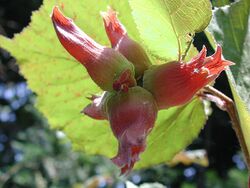Biology:Corylus maxima
| Filbert | |
|---|---|

| |
| Filbert fruits, showing the elongated tubular involucre | |
| Scientific classification | |
| Kingdom: | Plantae |
| Clade: | Tracheophytes |
| Clade: | Angiosperms |
| Clade: | Eudicots |
| Clade: | Rosids |
| Order: | Fagales |
| Family: | Betulaceae |
| Genus: | Corylus |
| Species: | C. maxima
|
| Binomial name | |
| Corylus maxima Mill.
| |
| Synonyms[2] | |
| |
Corylus maxima, the filbert, is a species of hazel in the birch family Betulaceae, native to southeastern Europe and southwestern Asia, from the Balkans to Ordu in Turkey.[3]
It is a deciduous shrub 6–10 m (20–33 ft) tall, with stems up to 20 cm (8 in) thick. The leaves are rounded, 5–12 cm (2–4 3⁄4 in) long by 4–10 cm (1 1⁄2–4 in) broad, with a coarsely double-serrated margin. The flowers are wind-pollinated catkins produced in late winter; the male (pollen) catkins are pale yellow, 5–10 cm (2–4 in) long, while the female catkins are bright red and only 1–3 mm (1⁄16–1⁄8 in) long. The fruit is a nut produced in clusters of 1–5 together; each nut is 1.5–2.5 cm (1⁄2–1 in) long, fully enclosed in a 3–5 cm (1 1⁄4–2 in) long, tubular involucre (husk).[3][4]
The filbert is similar to the related common hazel, C. avellana, differing in having the nut more fully enclosed by the tubular involucre. This feature is shared by the beaked hazel C. cornuta of North America, and the Asian beaked hazel C. sieboldiana of eastern Asia.
Uses
The filbert nut is edible, and is very similar to the hazelnut (cobnut). Its main use in the United States is as large filler (along with peanuts as small filler) in most containers of mixed nuts. Filberts are sometimes grown in orchards for the nuts, but much less often than the common hazel.[3][4]
The purple-leaved cultivar Corylus maxima 'Purpurea' is a popular ornamental shrub in gardens.[5]
Language
In Oregon, "filbert" is used for commercial hazelnuts in general. Use in this manner has faded partly due to the efforts of Oregon's hazelnut growers to brand their product to better appeal to global markets and avoid confusion.[6][7]
The etymology for 'filbert' is Norman French. Saint Philibert's feast day is 20 August (old style) and the plant was possibly renamed after him because the nuts were mature on this day.[8]
References
- ↑ Rivers, M.C.; Beech, E. (2018). "Corylus maxima". IUCN Red List of Threatened Species 2018: e.T194619A122039374. doi:10.2305/IUCN.UK.2018-2.RLTS.T194619A122039374.en. https://www.iucnredlist.org/species/194619/122039374. Retrieved 31 July 2023.
- ↑ "Corylus maxima Mill.". Board of Trustees of the Royal Botanic Gardens, Kew. 2017. https://powo.science.kew.org/taxon/urn:lsid:ipni.org:names:295467-1.
- ↑ 3.0 3.1 3.2 Rushforth, K. (1999). Trees of Britain and Europe. Collins ISBN:0-00-220013-9.
- ↑ 4.0 4.1 Flora of NW Europe: Corylus maxima
- ↑ "RHS Plant Selector - Corylus maxima 'Purpurea'". http://apps.rhs.org.uk/plantselector/plant?plantid=555. Retrieved 19 July 2013.
- ↑ Oregon Hazelnut Marketing Board
- ↑ Agriculture Quarterly – Oregon Department of Agriculture
- ↑ Oxford English Dictionary.
Wikidata ☰ Q1801446 entry
 |



